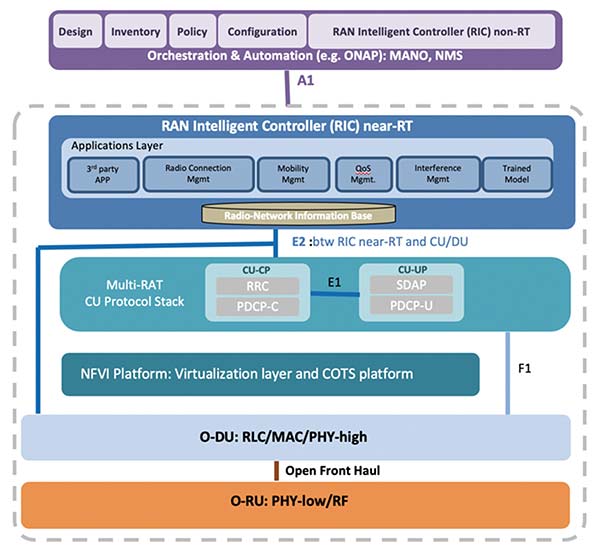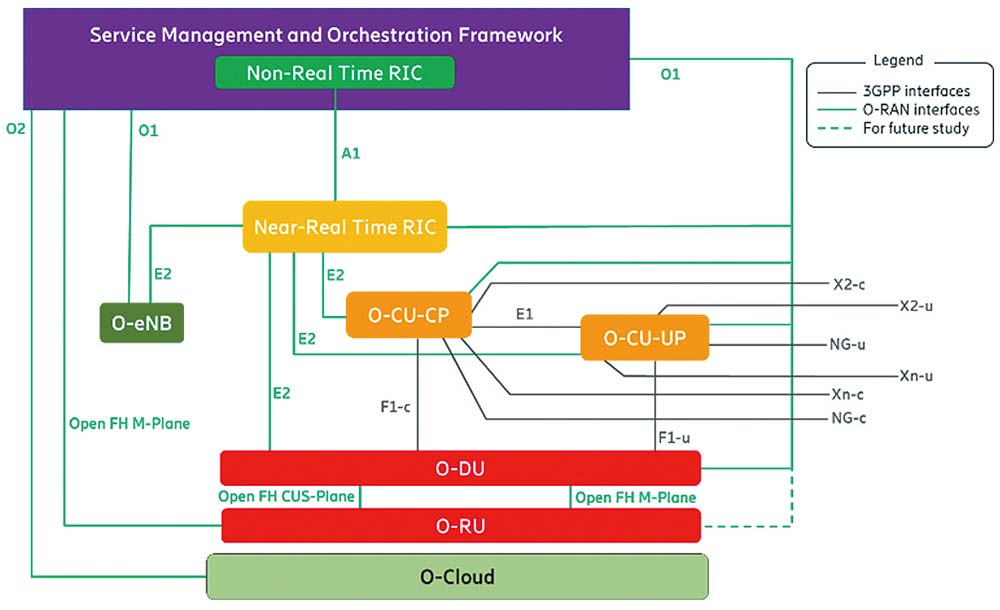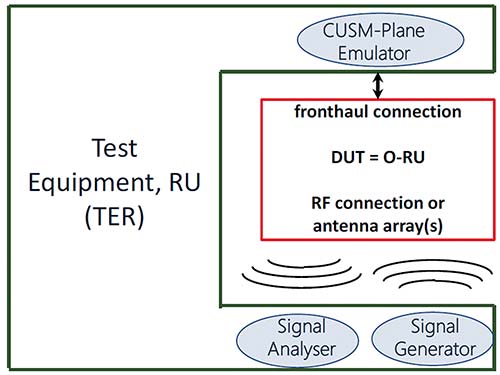Mobile network operators are constantly looking for ways to improve the network experience for their subscribers, while at the same time making their networks more efficient, capable and cost-effective.
Currently, operators are focusing on Open Radio Access Network (Open RAN), as it promises a more cost-effective and agile RAN that can be used for 4G, 5G and beyond 5G networks.
Designed around the use of open interfaces, commercial off-the-shelf (COTS) hardware, and possibly open-source software, Open RAN offers a number of benefits. Among these is lower costs. CAPEX can be reduced thanks to the economies of scale provided by a multi-vendor ecosystem, while OPEX is also lowered because of the use of learning-based technologies to power RAN automation.
Lower RAN costs allow mobile operators to serve more cost-sensitive 5G network use cases, for example, rural markets or private 5G networks. Open RAN can also use APIs that readily plug into open systems developed by new entrants to the market.
Open RAN offers improved efficiency and performance thanks to better management of radio resources achieved through real-time and non-real-time RAN Intelligent Controllers (RICs). Expanding network capability is also simplified because of Open RAN’s cloud-native infrastructure and the use of Agile Continuous Integration, Continuous Test, and Continuous Deployment methods (CI/CT/CD).
Building blocks of Open RAN
Open RAN can be deployed using either LTE or 5G, and splits traditional base station hardware and software into Open-Centralized Unit (O-CU), Open-Distributed Unit (O-DU), and Open-Radio Unit (O-RU), all with open interfaces.
Engineers need to understand the implications of such a split, particularly at the O-RU and O-DU layers connected via the Open Fronthaul Interface (O-FH). For example, radio in a traditional base station is typically sent over-the-air (OTA). With Open RAN, it travels first as IQ data over the O-FH before it is sent OTA.

Figure 2: O-RAN Architecture. (Source: O-RAN ALLIANCE WHITE PAPER, ”O-RAN: Towards an Open and Smart RAN,” p.10.)
Intelligent radio controllers unleash the potential of a fully automated network. The architecture proposed by the O-RAN ALLIANCE (O-RAN) uses COTS hardware and virtualized software to provide numerous hierarchical cloud deployment options for operators. Open RAN provides the cloud framework to help operators automate the deployment and provisioning of O-RAN based radio access networks.
The O-RAN architecture consists of Virtualized Network Functions (VNFs) and/or Physical Network Functions (PNFs). Also included is a Service Management and Orchestration (SMO) framework to manage the network functions.
Test regime guided by O-RAN ALLIANCE
Formed by some of the leading global operators, the O-RAN ALLIANCE defines open standards and interfaces for interoperability between O-RU, O-DU, and O-CU. The O-RAN ALLIANCE has test labs known as Open Testing and Integration Centers (OTICs). A number of test and measurement vendors participate in events held at these centres to help develop test solutions for Open RAN verification and deployment.
The O-RAN ALLIANCE provides procedures for certifying and badging vendor equipment – these ensure equipment conformance, interoperability, and performance based on specifications. Certification is applied using conformance tests to confirm that an individual device-under-test (DUT) meets the O-RAN technical specification.
Two badges – interoperability tests (IOT) and end-to-end (E2E) tests – can be acquired. These involve multiple DUTs from different vendors. IOT assesses the interoperability of DUT pairs using O-RAN Interoperability Test specifications.
E2E system integration badging is defined as an assessment of end-to-end system integration of DUT groups that are implemented according to O-RAN interfaces using O-RAN E2E test specifications.
E2E test requirements and methods are similar to a monolithic base station but with additional test sequences that include the O-FH verification – the RF interface verification is the same as the 3GPP BTS test specifications.
“Wrap-around” test setup for O-RU and O-DU as Subsystem Pair under Test

Figure 3: E2E Test Configuration for O-RU and O-DU Subsystems. (Source: ”O-RAN End-to-End System Testing Framework Specification 1.0,” p. 34.)
Emulated network functions include a UE simulator for functional/load tests, ensuring a framework for comprehensive evaluation and testing before the start of E2E system testing.
“Wrap-around” testing is used to verify the O-RU and O-DU and involves emulating or using reference test platforms for the relevant subsystems to create real-world environments as defined in the O-RAN Deployment Blueprint. Reference test platforms can be subsystems designed for commercial purposes or test applications, which are used to support the wrap-around test setup.
The reference test platform, or test application, should be capable of “full speed” online operation to measure KPIs. An offline test tool can conduct O-RU conformance tests but not interoperability and E2E KPI tests.
Testing O-RAN poses challenges
To implement Open RAN successfully, a comprehensive testing strategy must be developed. This poses challenges due to the open environment and the multitude of players that vary in size and experience. At a minimum, Open RAN elements and networks must meet the performance of 5G monolithic systems.
Test solution providers who are active members of the O-RAN ALLIANCE can gain a greater understanding of specifications, open software development, testing needs, and integration.
Among the tests that must be conducted are:
- RU RF Performance Test – Follows 3GPP requirements to verify RF parametric values of RU radio elements.
- O-FH Conformance Test – Verifies O-RU conformance to O-FH interface and related performance of O-RU.
- O-FH Interoperability Test – Verifies interoperability between different O-RU and O-DU suppliers/implementations.
- End-to-End System Testing – Assures sub-system and E2E performance against KPIs.
- Open X-Haul Transport Network Testing (Real World I&M test) – Assures Transport Network requirements.

Figure 4 O-RAN Fronthaul Conformance Test Configuration. (Source: ”O-RAN Conformance Test Specification 6.0,” p. 22.)
Figure 4 outlines a configuration to test O-RAN fronthaul conformance. The O-RU is connected to Test Equipment O-RU (TER), which surrounds the DUT and connects to the fronthaul interface and radio interface to make measurements.
The TER has three main components – a CUSM-Plane Emulator (CUSM-E), a signal analyzer, and a signal generator to perform RF measurements.
The TER collects RF signals from the DUT (Downlink: DL) and sends RF signals to the DUT receiver (Uplink: UL) at the radio interface. The DL data flow is evaluated based on what is received by the signal analyzer in the RF domain as radiated by the O-RU. The UL data flow is evaluated based on what is emitted by the signal generator in the RF domain as received by the CUSM-E.
When conducting tests, engineers must be aware of considerations specific to the Open RAN ecosystem.
Among these are:
- Wide range of DU+RU combinations leads to numerous test cases.
- Multi-vendor RAN is new to many vendors and operator test engineers.
- Partnering with third-party integrators is beneficial to target E2E test solution based on key players in question.
- Conformance, compliance, and interoperability certifications needed in supply chain.
- Capacity, performance, and compliance testing with emulation of Open RAN nodes, interfaces, and RF channels support key deployment KPIs.
- Difficulty of reproducing field synchronization, latency and performance issues in the lab
- Multiple use cases may require specific measurements/testing.
- Require test solutions that integrate Open RAN to existing brownfield implementation.
Open RAN architecture is used across different vertical industries, with different levels of customization. Combined with a large number of new companies entering the market, we need to ensure elements work together seamlessly. Automated testing is required to reduce complexity, as well as control test costs and cut time-to-market.
Test solutions that are completely integrated with standards and can perform the tests in a few keystrokes offer the required accuracy, repeatability, and speed. Flexible platforms that support updates as specifications evolve are also beneficial for Open RAN.
Also useful are software-based solutions that automatically update 3GPP test cases in test tools, saving time and money for production test environments.
The Open RAN architecture can create an open environment that adds flexibility, intelligence, and cost efficiency to 4G and 5G networks and aims to help build smarter, innovative, and cost-effective mobile infrastructure.
Ensuring that Open RAN is widely adopted demands sound testing to assure Open RAN compatibility and network security.
 Author:
Author:
Sundara Venkatesh,
Market Development
ANRITSU




